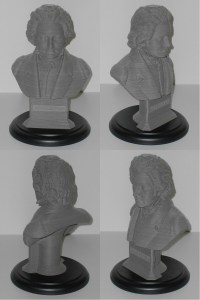Virtual Beethoven
(November 2003 - February 2004)
(Pictures of my creations can also be found in my BrickShelf folder)
1. The idea
 I've always wanted to build a sculpture - a large sculpture. Unfortunately I'm not a sculptor.
I've always wanted to build a sculpture - a large sculpture. Unfortunately I'm not a sculptor.
That's when I came up with the following idea:
If I have a three-dimensional scan of an object, it can easily be transformed into LEGO (height = 2/5 width when using plates, height = 6/5 width when only using bricks). But how can I make this three-dimensional scan? When graduating as an industrial engineer, I remember working with a three-dimensional measuring device during one of the lab-sessions. I just couldn't remember how data was stored, so I didn't start writing code to transform to LEGO immediately (I could use some help for this fase because I'm not really a programmer: I am very good with mathematical algorithms, but I can't really implement them into computer-language properly).
I finally came up with a nice solution:
I bought a 3D Sculpture Puzzle from Really Useful Games Company Limited. I scanned all layers one by one, and resized them to LEGO-scale. The most difficult part was to align consecutive layers; it was done with the naked eye (some layers were slightly rotated on my scanner, I had to bring them back in the right position).
I think that the computer-generated mathematical sculptures from Andrew Lipson were also a source of inspiration to build this model...
I hope Henry Lim will forgive me...
2. Start building
First I had to decide how big the statue would be. If I only use bricks, the statue would end up being more than 200 bricks high (there were approximately 200 layers in the original Sculpture Puzzle). I finally decided to use plates as well: when I use 1x2 jumper plates (lots of them), I can align consecutive layers in a half-stud fashion. This way, I can preserve more details from the original statue.
I made every layer two plates high, the finished model is 135 bricks high.
Just a few of the possibilities of how to align two layers half-stud in one or two directions:

3. Watch it grow
4. Other pictures
5. Bill of materials
To build this virtual model I used 63540 LEGO elements, mostly plates, tiles and jumper plates.
Here's a list of the most common elements. If I intended to build this model with real LEGO elements, just imagine how much it will cost to buy all the necessary parts through LEGO Shop at Home (#10115, #10064, #10060,...) or Bricklink (there are hardly enough jumper plates available!). It would probably cost me more than 5000 euro/dollar, merely to acquire all the pieces.
If somebody at the LEGO Company likes this statue, maybe they can provide me with the necessary pieces ;-).
| 3794 | Plate 1 x 2 with 1 Stud | 28374 x |
| 3070B | Tile 1 x 1 with Groove | 5919 x |
| 3710 | Plate 1 x 4 | 4027 x |
| 3069B | Tile 1 x 2 with Groove | 3451 x |
| 3666 | Plate 1 x 6 | 2969 x |
| 3020 | Plate 2 x 4 | 2664 x |
| 3623 | Plate 1 x 3 | 2621 x |
| 3021 | Plate 2 x 3 | 1531 x |
| 3460 | Plate 1 x 8 | 1497 x |
| 3023 | Plate 1 x 2 | 1245 x |
| 2420 | Plate 2 x 2 Corner | 1198 x |
| 2431 | Tile 1 x 4 | 972 x |
| ... | ... | ... |
6. Comments
- Right from the start I decided that it should be possible to build this sculpture for real. That's why I made it 4 studs wide (most LEGO-sculptors only make their models 2 studs wide). The reason: when two consecutive layers are built in half-stud fashion, lots of 1x2 jumper plates are used. With a 4 studs wide wall, I still have 2 studs available to attach the next piece.
- There are no fortifications on the inside yet. I don't have to design them in MLCad, I only need them when the statue is build for real. Just keep in mind that these fortifications will also require lots of bricks...
- The original model has slight imperfections; they are also in my sculpture. I simply followed the building instructions that resulted from the scans. However I'm very pleased with the overall result. I just wish I could see it in real bricks...
6. Text

|
Did you notice the text on the pillar? I payed lots of attention to it. The letters are shifted backwards half-stud (again I used 1x2 jumper plates). For visibility reasons I made them dark grey instead of light grey.
Important remark: there is no glue required; every element is attached to another element with at least one stud.
|
The rendered images are created with MLCad, converted with L3P and rendered with POV-Ray.
The 3D Sculpture Puzzle is manufactured and sold under license from Really Useful Games.
 I've always wanted to build a sculpture - a large sculpture. Unfortunately I'm not a sculptor.
I've always wanted to build a sculpture - a large sculpture. Unfortunately I'm not a sculptor.








